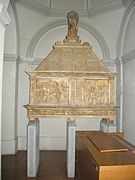Fidenza Cathedral
- View a machine-translated version of the Italian article.
- Machine translation, like DeepL or Google Translate, is a useful starting point for translations, but translators must revise errors as necessary and confirm that the translation is accurate, rather than simply copy-pasting machine-translated text into the English Wikipedia.
- Do not translate text that appears unreliable or low-quality. If possible, verify the text with references provided in the foreign-language article.
- You must provide copyright attribution in the edit summary accompanying your translation by providing an interlanguage link to the source of your translation. A model attribution edit summary is
Content in this edit is translated from the existing Italian Wikipedia article at [[:it:Cattedrale di San Donnino]]; see its history for attribution. - You may also add the template
{{Translated|it|Cattedrale di San Donnino}}to the talk page. - For more guidance, see Wikipedia:Translation.


Fidenza Cathedral (Italian: Duomo di Fidenza; Cattedrale di San Donnino) is a Roman Catholic cathedral in the center of the town of Fidenza, province of Parma, region of Emilia Romagna, Italy. It is the episcopal seat of the Diocese of Fidenza, known until 1927 as the Diocese of Borgo San Donnino. The lower facade retains its original Romanesque sculptural decoration
History

Construction of the cathedral began in the 12th century. It was dedicated to Saint Domninus of Fidenza, who was martyred by order of the Emperor Maximian in 304 AD. The saint's relics were brought here in 1207, and are believed to be contained in an urn in the crypt. The town's previous name, Borgo San Donnino, was given in honor of the saint.[1]
The church survived the sack and destruction of the town of Fidenza in 1268. The apse and façade were completed a few decades later. The upper part of the façade is incomplete, but the lower, with its three portals and sculptures, is a fine example of Romanesque architecture, including two statues by Benedetto Antelami[2] and bas-reliefs depicting the Histories of St. Domninus. The interior is simple and well-proportioned, and has not been spoilt by restoration. The statue at the front of the cathedral of the apostle Simon Peter is famous for its pointing in the direction of Rome. Fidenza was in fact a leg within the Via Francigena. Side chapels continued to be added into the 16th century.
Other low reliefs of the Anthelami's school are kept in the apse and in the diocesan museum of Fidenza.[3][4] The complex figurative programme intersects the Glory of Christ, episodes of the Old and the New Testament, the life of Saint Domninus and other medieval historical traditions, as well as legends and fantastic images. Pictures realized a book of the Christian faith,a book which was conceived with a didactic purpose and destinated to believers and pilgrims of different languages, cultures or completely illiterate. This was not unusual in the Middle Age's Roman Catholic cathedrals.
The altarpiece depicting the Purification of Mary, by Andrea Mainardi (il Chiaveghino) was painted for the church circa 1600.[5] The raised altar may be accessed by a series of smooth marble rungs that introduces to the choir. The episcopal seat is located in the west side of the altar, instead of the southern position which is more usual within the Modernist churches. Located at the extremity of the altar, two staircases which give access to the crypt where the holy relics of the saint are shown.
Sculptural decoration
Fidenza Cathedral, even in its incomplete state, preserves masterly Romanesque elements. The brick façade is flanked by two bell-towers, and has three entrance portals. The central portal has a protruding portico held aloft by thin columns with lion bases. Antelami in this portal sculpted the prophets David and Ezekiel flanking the doorway. In this portal, scenes narrate the life of Saint Domninus and subsequent miracles, who started as chamberlain to the Roman Emperor Maximian. Domninus' conversion led to his martyrdom. Other scenes depict the life of the Virgin, and a statue of Saint Peter. The side portals have carvings depicting Charlemagne and Pope Adrian II. Other carvings depict Hercules and the Nemean lion. Sculpted carvings continue in the inside of the church.[6]
- Lower register of bas reliefs on the west front: Domninus as chamberlain crowns Maximian; Maximian told of Domninus' conversion
- Central portal architrave: on the left, troops muster to execute Domninus; on the right, his decapitation, and angels transporting his head to Fidenza
- Bas reliefs on the west front: Saint Domninus saves a woman from a collapsed bridge
- Crypt with the ark containing the relics of San Donnino
References
- ^ Chisholm, Hugh, ed. (1911). "Borgo San Donnino" . Encyclopædia Britannica. Vol. 4 (11th ed.). Cambridge University Press. p. 250.
- ^ Diocese of Fidenza.
- ^ "Antelami a Fidenza. rivivere la Passio di san donnino" [Antelami in Florence. To live again the Passion of Saint Donnino] (in Italian).
- ^ "Fidenza, un percorso alla scoperta delle opere di Benedetto Antelami per Parma 2020+21" [Fidenza, a cultural pathr for the discovery of Benedetto Antelami's work within Parma 2020+21] (in Italian). October 7, 2020.
- ^ Museo del Duomo di Fidenza Archived 2017-02-02 at the Wayback Machine, entry on construction of the church.
- ^ Ars Romanica Archived 2017-09-14 at the Wayback Machine website dedicated to Romanesque art in Emilia-Romagna, established by L’Associazione Culturale Rabisch, with the Fondazione Casa Lyda Borelli. Citing
- Tesori e segreti delle cattedrali romaniche di Modena e Parma, Parma 2007
- Y. Kojima, Storia di una cattedrale: il duomo di San Donnino a Fidenza: il cantiere medievale, le trasformazioni, i restauri, Pisa 2006.
- I.Cogato, Pellegrini alla chiesa di San Donnino: il duomo di Fidenza, Fidenza 1998
- R. Tassi, Il duomo di Fidenza, Milano 1974.
44°51′59″N 10°03′28″E / 44.8665°N 10.0578°E / 44.8665; 10.0578














